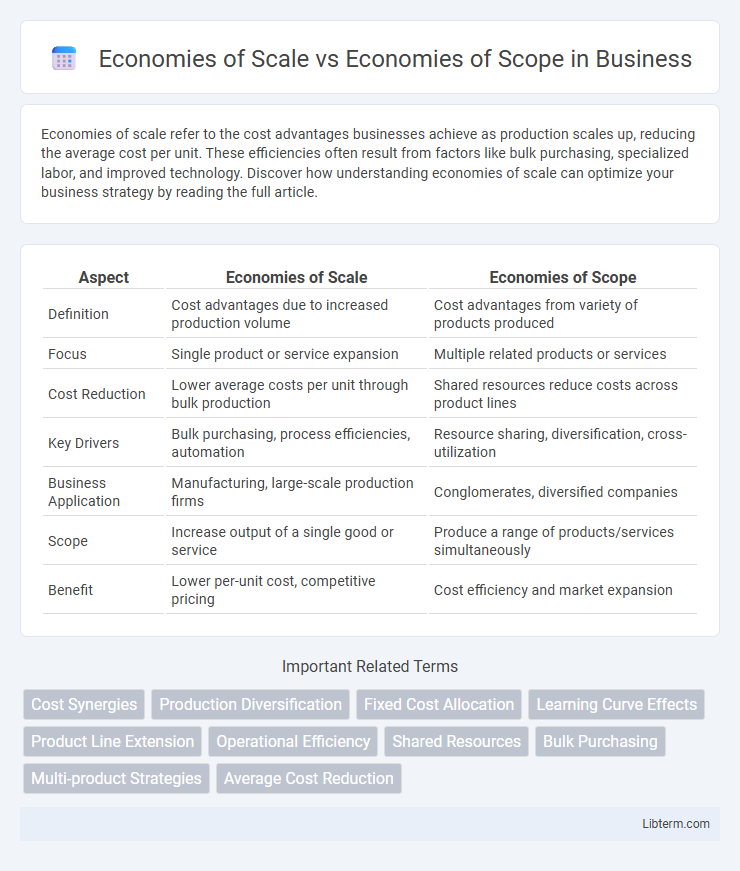Economies of scale refer to the cost advantages businesses achieve as production scales up, reducing the average cost per unit. These efficiencies often result from factors like bulk purchasing, specialized labor, and improved technology. Discover how understanding economies of scale can optimize your business strategy by reading the full article.
Table of Comparison
| Aspect | Economies of Scale | Economies of Scope |
|---|---|---|
| Definition | Cost advantages due to increased production volume | Cost advantages from variety of products produced |
| Focus | Single product or service expansion | Multiple related products or services |
| Cost Reduction | Lower average costs per unit through bulk production | Shared resources reduce costs across product lines |
| Key Drivers | Bulk purchasing, process efficiencies, automation | Resource sharing, diversification, cross-utilization |
| Business Application | Manufacturing, large-scale production firms | Conglomerates, diversified companies |
| Scope | Increase output of a single good or service | Produce a range of products/services simultaneously |
| Benefit | Lower per-unit cost, competitive pricing | Cost efficiency and market expansion |
Introduction to Economies of Scale and Scope
Economies of scale occur when increasing production reduces the average cost per unit due to factors like bulk purchasing, specialized labor, and efficient use of capital. Economies of scope arise from producing a variety of products together, leveraging shared resources, technology, or distribution channels to lower costs. Understanding both concepts is crucial for businesses aiming to optimize cost structures and enhance competitive advantage.
Defining Economies of Scale
Economies of Scale refer to the cost advantages that a business obtains due to expansion, resulting in a reduction in the average cost per unit as production volume increases. These cost reductions arise from factors such as operational efficiencies, bulk purchasing of materials, and enhanced specialization of labor and equipment. Achieving significant Economies of Scale can lead to competitive pricing, higher profit margins, and increased market share for large-scale producers.
Understanding Economies of Scope
Economies of scope arise when a company efficiently produces a variety of products using shared resources, reducing average costs by leveraging existing capabilities across multiple outputs. This concept contrasts with economies of scale, which focus on cost advantages gained from increasing the volume of a single product. Understanding economies of scope highlights the strategic value of diversification and resource allocation in enhancing overall operational efficiency.
Key Differences Between Scale and Scope
Economies of scale refer to cost advantages achieved by increasing production volume, resulting in lower per-unit costs through factors like bulk purchasing and operational efficiencies. Economies of scope arise from producing a variety of related products together, which reduces costs by sharing resources, technologies, or processes across multiple product lines. The key difference lies in scale focusing on quantity expansion within a single product, while scope emphasizes diversity and resource sharing across different products.
Types of Economies of Scale
Internal economies of scale arise from factors within a firm, such as technical improvements, managerial efficiency, and bulk purchasing, which lower average costs as production volume increases. External economies of scale occur when industry growth leads to benefits like improved infrastructure, specialized labor pools, and supplier networks, reducing costs for all firms in the market. Other types include financial economies through better access to capital and risk-bearing economies where larger firms can diversify product lines to stabilize revenue streams.
Types of Economies of Scope
Economies of scope arise when a firm efficiently produces a range of products using shared resources, reducing average costs compared to producing each product separately. Types of economies of scope include joint products, where by-products are produced from common inputs, and operational economies, achieved by sharing marketing, distribution, or management services across multiple product lines. Other forms involve financial economies, such as risk reduction through diversified portfolios, and technological economies, leveraging shared R&D and innovation across product categories.
Benefits and Limitations of Economies of Scale
Economies of scale provide cost advantages by increasing production volume, which lowers the average cost per unit through factors like bulk purchasing, specialized labor, and efficient technology. The primary benefit lies in enhanced competitiveness and higher profit margins due to reduced operational costs, enabling firms to invest in innovation and market expansion. However, limitations include risks of diseconomies of scale such as increased complexity, managerial inefficiencies, and reduced flexibility, which can offset cost savings and hinder responsiveness to market changes.
Advantages and Challenges of Economies of Scope
Economies of scope offer advantages such as cost savings through shared resources, diversified product lines, and enhanced market reach, allowing firms to leverage existing capabilities efficiently. Challenges include increased complexity in management, potential dilution of brand identity, and the need for significant coordination across diverse operations. Successfully balancing these factors can lead to competitive advantages by optimizing resource utilization and reducing average costs across multiple products or services.
Real-World Examples: Scale vs Scope
Economies of scale are evident in manufacturing giants like Toyota, which reduce average costs by increasing production volume through standardized processes and bulk purchasing. Economies of scope appear in conglomerates like Amazon, leveraging diverse product lines such as e-commerce, cloud computing, and entertainment to share resources and reduce costs across different business units. Firms exploiting economies of scale focus on cost advantages from size, while those leveraging economies of scope benefit from cost savings via product variety and operational flexibility.
Strategic Implications for Businesses
Economies of scale enable businesses to reduce per-unit costs by increasing production volume, enhancing competitiveness through cost leadership. Economies of scope allow firms to leverage shared resources across diverse products or services, facilitating market diversification and risk reduction. Strategically, combining both economies supports sustainable growth by optimizing operational efficiency and expanding market reach simultaneously.
Economies of Scale Infographic

 libterm.com
libterm.com